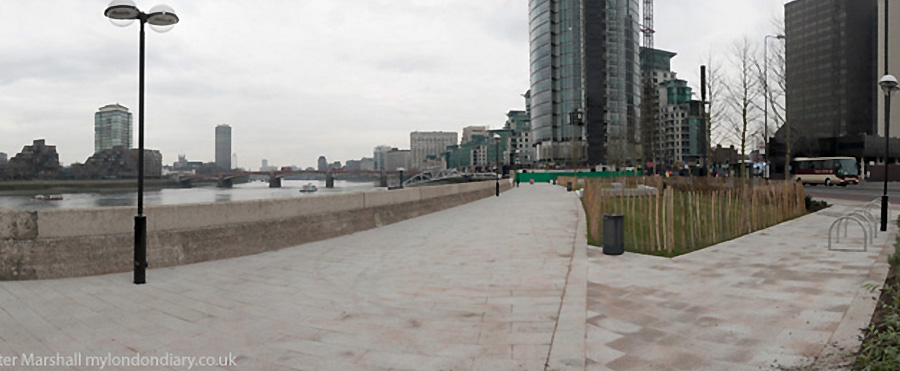My trip to Vauxhall showed two real advantages of digital over film. I’d gone there to photograph a protest: Capgemini Cleaners Demand Living Wage – but when I got off the bus at the stop just across the road they were nowhere to be seen. I was a few minutes early, and from experience I knew they didn’t always start their protests on time, so I wasn’t too surprised.
But rather than just hang around, I went for a little walk, starting off by going to the riverside, where thing had changed a little since I was last there. South of Vauxhall Bridge used to be the Nine Elms cold store, a vast concrete slab from the early 1960s, demolished in 1999, having been disused for some years – it enjoyed a brief afterlife as a recording studios in 1990. Part of this St George’s Wharf area was fairly quickly redeveloped as rather quirky expensive riverside flats, certainly not to everyone’s architectural taste (if taste is the right word for them), but the 185 metre tall cylindrical Vauxhall Tower took some time to get planning permission (a GLA folly along with the Shard) and has yet to be completed. One of the objections was I understand that it might be a danger to helicopters coming along the Thames to land at nearby Battersea Heliport, and in January this proved only too true, with two men being killed when a helicopter hit one of the cranes at its top in fog.
I made a panorama here in 1999, in which the remains of part of the cold store are visible above the green diamond of grass to the right of the trees (see detail below.) To its left the St Georges Wharf site is clear and you can see past to the MI6 ‘Spook’s Castle’ immediately north of Vauxhall Bridge.
I decided on the spot to make a digital panorama from what I thought was the same position. Working from memory, I went about a couple of meters too far south, but it wasn’t too bad a guess. The whole panorama is too wide to sensibly show in this blog, but I have included it on my London Diary in Vauxhall Images. Here is a crop from the centre of the image, taken in light that made the most of the view:

Vauxhall: Crop from centre of panorama taken in 1999. © 1999, Peter Marshall
Had Vauxhall Tower been there in 1999, I think I would have only have recorded the lower 13 or 14 of its 52 floors on the film image, taken with a 26mm lens on a roughly 56mm length of 35mm film – just over one and a half times the length of a normal 35mm negative. The horizontal angle of view was roughly 120 degrees, and the camera had a ‘swing’ lens that rotated to project the image onto a curved film, avoiding the ‘wide angle distortion’ which makes images with a horizontal angle of view of more than around 90 degrees impossible on normal rectilinear lenses. The result uses a cylindrical projection, which takes a little getting to grips with.
Here’s roughly the same area from a picture taken in poor light when I was waiting for the protest a week or two ago:

Vauxhall: Crop of same area from centre of panorama taken in March 2013. © 2013, Peter Marshall
Even from the crop you can see that the film image is a better picture, mainly because of the lighting, but also because of the changes in the scene. I also took rather longer thinking exactly where to take it from, and the small difference in position does make a better picture, particularly since moving forward a little gave me a slightly better view of the river and a better angle on the patch of grass – which was then unfenced.
With digital, there are no real limits on the horizontal angle of view – you just take more pictures to stitch together – and really very little on the vertical angle. Using a focal length of 16mm with the camera in portrait orientation didn’t quite allow me to get the top of the tower in view, so I simply took another row of images with the camera angled up, and let PtGui (with a little help from me in masking some images) put the whole lot together. As you can see in Vauxhall Images I decided to stop at around 180 degrees horizontal, and I’ve also included there a section of the digital image cropped to the same angular dimensions, in Vauxhall Images. Had I set out to produce something more like my original picture I would have worked with a different lens with a less wide view and would only have needed a single row of images.
Although digital allows much more freedom in making panoramas (and the results are technically better in almost every respect too) it is can be more time-consuming, having to make the dozen or so exposures needed, and gives problems with subjects that move. But stitching the images together is often faster than scanning a film image to make prints.
In terms of technical quality, the digital image, produced on the D800E wins hands down, enabling considerably larger prints. So although I still like using film for panoramas in cameras such as the Horizon or the Hassleblad X-Pan, and they do have the advantage of giving a decent idea of the finished image in the viewfinder, in most respects digital wins hands down.
A few minutes after taking these images I walked along towards Vauxhall bus station, where I found the cleaners were gathering to start their protest. But more about that in my next post.